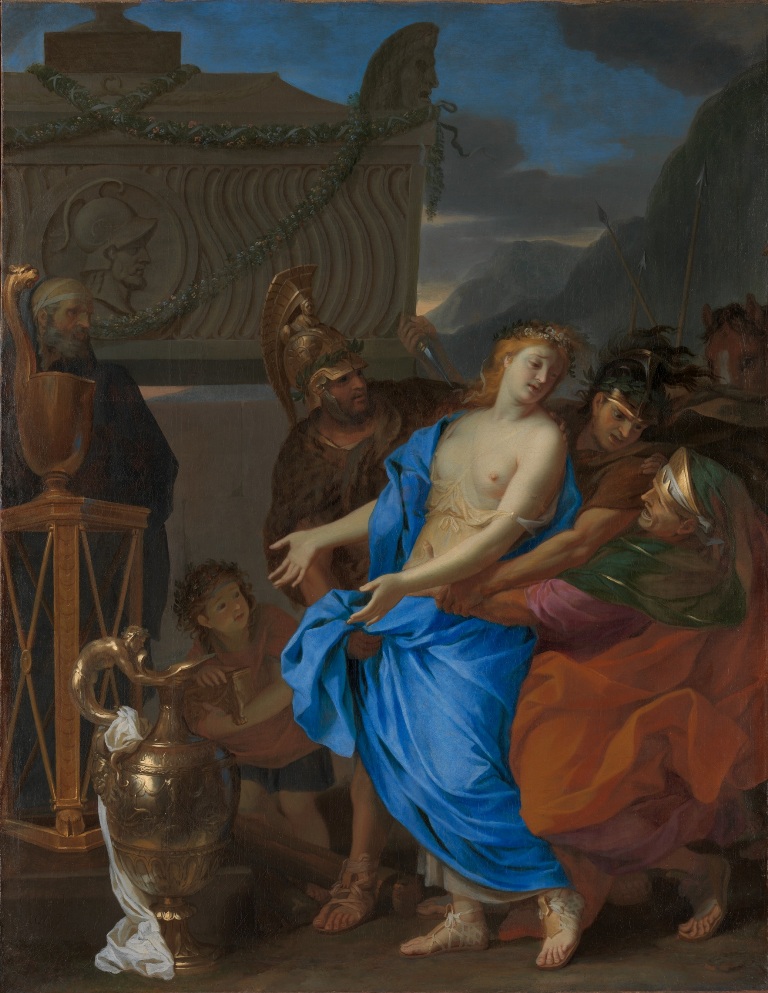In this, the quietest season of the year for the New York art world, when most of the commercial galleries are shuttered and the museums have been abandoned to the tourists, it behooves the critic to slow down for a few weeks and smell the flowers. By that I mean returning to the permanent collections and observing the recent addition of several significant objects. I refer in specific to two seventeenth-century paintings that have just entered the collections of the Metropolitan Museum: Saint Francis in Ecstasy by the Genoese master Giovanni Benedetto Castiglione and The Sacrifice of Polyxena by Charles Le Brun.
 These are not exactly blockbuster acquisitions and have not even been done the honor of a press release. Rather, when no one was looking, they quietly appeared out of nowhere, assuming their places among the immortals of the collection. One will not love the Old Master tradition because of these two works: rather one will love these two works because they form part of that tradition. Both represent the baroque style almost-but not quite-on autopilot. Both are good paintings by artists who have done better. Of the two, I prefer the Saint Francis, and I would say that square foot by square foot, or square inch by square inch, Castiglione is the better, surely the more enjoyable, painter, here and elsewhere.
These are not exactly blockbuster acquisitions and have not even been done the honor of a press release. Rather, when no one was looking, they quietly appeared out of nowhere, assuming their places among the immortals of the collection. One will not love the Old Master tradition because of these two works: rather one will love these two works because they form part of that tradition. Both represent the baroque style almost-but not quite-on autopilot. Both are good paintings by artists who have done better. Of the two, I prefer the Saint Francis, and I would say that square foot by square foot, or square inch by square inch, Castiglione is the better, surely the more enjoyable, painter, here and elsewhere.
Above: Saint Francis in Ecstasy by Giovanni Benedetto Castiglione, c. 1650. Oil on canvas. Metropolitan Museum of Art.
Painted in Rome around 1650, his tumultuous and stormy composition, angled upwards from below, breathes the spirit of his age. And in certain details, like the skull at the feet of Saint Francis, as well as his sackcloth robe, his crucifix, and the nimbus around his head, you sense, in the striated brushstrokes, that oleaginous richness of texture that is the finest thing about Castiglione, an artist better known for his depictions of animals.
 Le Brun’s painting was likewise painted in Rome, some three years earlier, in 1647. In terms of advancing his career, Charles Le Brun was infinitely more successful than Castiglione. He was premier peintre to Louis XIV, who called him (according to Hugh Honor quoted in Wikipedia) “the greatest French artist of all time.” Whatever the Sun King’s other attainments, a discernment in matters of fine art was not eminently among them. The composition of this painting is as tumultuous as that of Saint Francis, but one suspects that it is unintentionally so, that it exhibits a complexity that has begun to elude the painter’s control. In it we see Polyxena at the moment when Neoptolemus prepares to slit her throat, dispatching her as a sacrifice to the gods so that the Greeks might have fair winds as they depart Troy. The paint textures are, as we would say today, “phoned in,” and only the dazzling gold ewer at the base of the canvas shows the initiative of which Le Brun was capable at his best. Still, it is a handsome work overall, and we should be glad to welcome it into the Met’s collection.
Le Brun’s painting was likewise painted in Rome, some three years earlier, in 1647. In terms of advancing his career, Charles Le Brun was infinitely more successful than Castiglione. He was premier peintre to Louis XIV, who called him (according to Hugh Honor quoted in Wikipedia) “the greatest French artist of all time.” Whatever the Sun King’s other attainments, a discernment in matters of fine art was not eminently among them. The composition of this painting is as tumultuous as that of Saint Francis, but one suspects that it is unintentionally so, that it exhibits a complexity that has begun to elude the painter’s control. In it we see Polyxena at the moment when Neoptolemus prepares to slit her throat, dispatching her as a sacrifice to the gods so that the Greeks might have fair winds as they depart Troy. The paint textures are, as we would say today, “phoned in,” and only the dazzling gold ewer at the base of the canvas shows the initiative of which Le Brun was capable at his best. Still, it is a handsome work overall, and we should be glad to welcome it into the Met’s collection.
Above: The Sacrifice of Polyxena by Charles Le Brun, 1647. Oil on canvas. Metropolitan Museum of Art, bequest of Grace Wilkes and Fletcher Fund by exchange.

